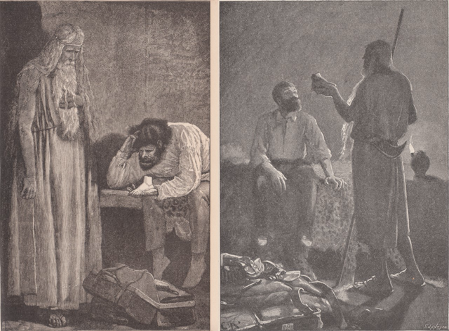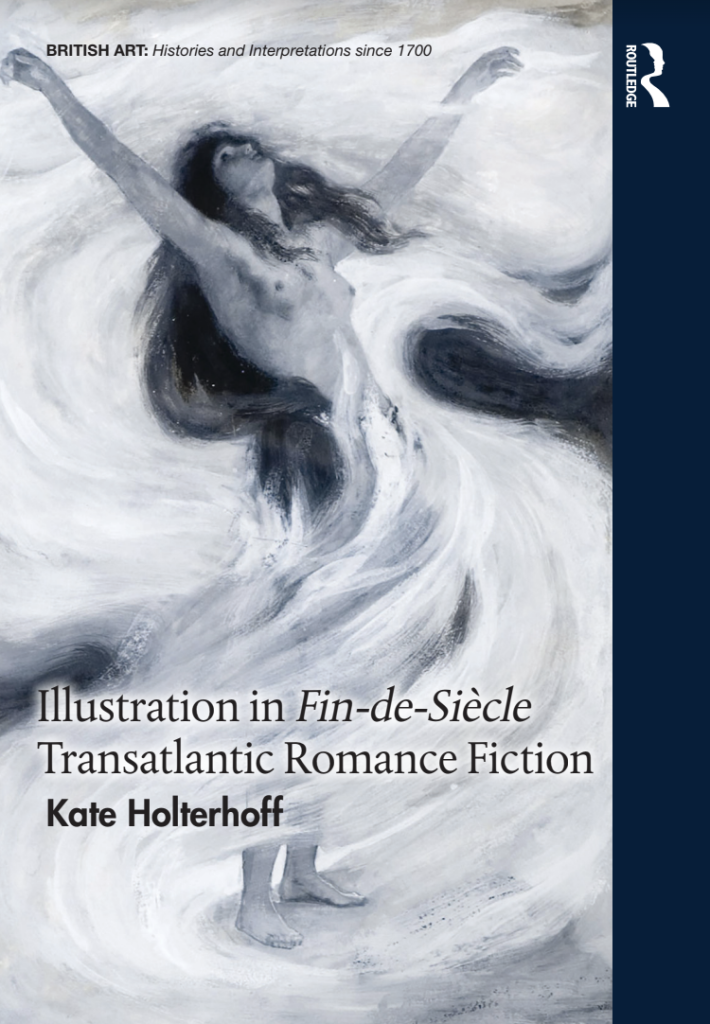by Kate Holterhoff
Kate Holterhoff received her doctorate from Carnegie Mellon University and is currently an Affiliated Researcher at the Georgia Institute of Technology. Her new monograph, Illustration in Fin-de-Siècle Transatlantic Romance Fiction (Routledge, 2022) is available now.
This post contains excerpts from the Introduction of Kate’s monograph.

(Right) Charles Kerr, “Holly and Billali” from She, A History of Adventure by H. Rider Haggard (London: Longmans, Green, and Co., 1912): 110.
Although horrors and wonders exceeding the bounds of human perception and understanding were conventional in late-Victorian and Edwardian romance fictions, the illustrations which appeared beside these marvels suggested that, when it comes to visual paratexts, quite the opposite was thought to be the case. When fin-de-siècleillustrators undertook the task of illuminating moments that novelists left opaque, artworks challenged these wonders’ supposed inexpressibility. Illustrations from many of the most popular and wild-minded fictions published between 1885 and 1920 round out the reader’s aesthetic, narrative, cultural, and emotional experience, and therefore can never be mimetic reflections of authorial intent.
Both realist and romance fictions were illustrated during the late nineteenth century for their initial serializations, but there is good reason to focus on romance illustrations particularly. The Romance Revival was tremendously visual, not only because of illustration’s ubiquity, but also owing to the type of wonders described. Readers were struck by romance fiction’s spectacles, which profoundly surpassed reader’s lived experiences. Robert Louis Stevenson points to the form’s optic qualities in “A Gossip on Romance” (1882), explaining that a good story must “repeat itself in a thousand coloured pictures to the eye.” (1) Tableaus of wonder made deep and lasting impressions upon audiences. Indeed, Graham Greene notes that H. Rider Haggard’s fictions “fixed pictures in our minds that thirty years have been unable to wear away.” (2)] The illustrations which accompanied these fictions did more than mimetically reproduce romance’s visually impressive supernatural wonders, advanced technologies, violent battles, great feats of heroism, and titillating romantic trysts. By engaging the notion of inexpressibility, these graphic paratexts deepen romance fiction’s plots.
In H. Rider Haggard’s She (1887), for instance, narrator Horace Holly and his adult ward Leo Vincey journey to darkest Africa in search of the immortal and supernaturally powerful Queen Ayesha, or She-who-must-be-obeyed. Although wonders and adventures occur throughout, one of the most frequently illustrated portions of She shows Holly pondering a white, mummified foot (see fig. 1). This dismembered and perfectly preserved appendage is all that remains of a beautiful mummy that Billali, the adventurers’ Amahagger guide to Ayesha’s kingdom of Kôr, had become enamored with in his youth. In fact, it was Billali’s mother who burned all but this mummy’s extremity to end her son’s unnatural infatuation. After learning the foot’s remarkable history Holly explains that he, “took this cold fragment of mortality in my hand and looked at it in the light of the lamp with feelings which I cannot describe, so mixed up were they between astonishment, fear, and fascination.” (3) This supernaturally unspoiled foot—its appearance, materiality, and history—resonates so deeply with Haggard’s narrator that verbalizing, or even processing, his complex emotions becomes impossible. It touches on something much deeper than horror or antiquarian interest. Although Haggard leaves the substance of the foot’s mystery open to the interpretation of readers, artists beginning with E. K. Johnson (illustrator for The Graphic and Harper’s Weekly’s serializations), and followed by Charles Kerr (co-illustrator with Maurice Greiffenhagen for the 1888 Longmans, London, book edition), have sought to convey its power and seductiveness.
What made Haggard’s illustrators not only willing, but also eager, to show a marvel that Haggard will not, and Holly “cannot describe”? Rendering indescribable scenes like this eerie drama in She, but also includingfictional technologies, lands, creatures, peoples, and circumstances graphically allowed these artists to add both concrete detail and greater mystery to these incredible stories. I focus on romance fiction because these texts were visualized despite, or perhaps because, authors explicitly wrestled with ideas of ineffability. Far from being put off by wild visions of terror and wonder, portraying incidents characterized as surpassing the author’s or narrator’s expressive abilities invigorated artists. Whether on purpose or accident, by including indescribable marvels authors granted their illustrators near total liberty to fill in gaps in the reader’s understanding. These unimaginable moments permit word and image to labor hand-in-hand, deepening the audience’s engagement with a text’s more profound themes.
My monograph Illustration in Fin-de-Siècle Transatlantic Romance Fiction (2022) sets out to investigate the literary, historical, cultural, and aesthetic clues illuminating how images in late-nineteenth and early-twentieth-centuryBritish and American romance fiction enabled artists to visualize wonders thought to surpass human description. In the process, I point to the innovative collaborations that authors, illustrators, and publishers forged to describe the ostensibly ineffable. The book is divided into five chapters focusing on a single author, genre, and theme. Each begins with a broad history of illustration within the genre, but then focuses on one canonical late-nineteenth-century author as a case study. Chapter one examines how unimaginable because bygone eras appeared in Robert Louis Stevenson’s historical romances Treasure Island and The Black Arrow. Chapter two examines the pictorially-resistant convention in children’s fiction of expressive animals in Rudyard Kipling’s “Her Majesty’s Servants,” “Toomai of the Elephants,” and “How the Camel Got His Hump” (two stories from The Jungle Books and one from the Just So Stories, respectively). The third chapter explores several indescribably powerful and sexually alluring African women from H. Rider Haggard’s adventure fictions, focusing particularly upon the characters of Nanea from Black Heart and White Heart, Maiwa from Maiwa’s Revenge, and Ayesha as she appears in the She franchise. Chapter four surveys and assesses pictures of incredible technologies from several of H. G. Wells’s fictions, including “In The Abyss,” The War of the Worlds, When the Sleeper Wakes, and A Story of the Days to Come. Fanciful machines often defy description, either owing to the narrator’s inability to characterize them faithfully, or else because they were too advanced to describe using nineteenth-century analogies. The final chapter examines illustrations that engage the unspeakable horror of cannibalism conducted by and upon supposedly civilized white persons, looking especially at Harper’s Weekly’s serialization of James De Mille’s imperial Gothic romance A Strange Manuscript Found in a Copper Cylinder.
Illustration in Fin-de-Siècle Transatlantic Romance Fiction studies illustrations created to enhance romance fiction plots incorporating magic, technology, desire, violence, and other marvels that thwart written representation because these multimodal texts provide illustrators with the dual burden and opportunity of visualizing unspeakable ideas. I endeavor to better understand the complex bonds joining word to image in order to plumb what romance illustrations of indescribable marvels can, and do, accomplish.
(1) H. Rider Haggard, She, ed. Andrew M. Stauffer (Peterborough: Broadview, 2006), 117
(2) Robert Louis Stevenson, “A Gossip on Romance,” Longman’s Magazine 1 (November 1882): 69.
(3) Graham Greene, Collected Essays (New York: The Viking Press, 1969), 209.

